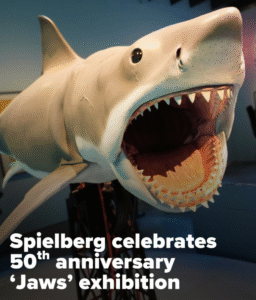Fifty years after it first terrified beachgoers and revolutionized Hollywood, Jaws is once again making waves—this time not in the ocean, but in the heart of Los Angeles. Steven Spielberg, now 78, returned to the film that launched his career to celebrate its golden anniversary with a sprawling, immersive exhibit at the Academy Museum of Motion Pictures. Titled “Jaws: The Exhibition,” it’s the largest museum show ever dedicated to a single film in the museum’s history.
This isn’t just a nostalgic tribute—it’s a deep dive into the making of a cinematic legend, a love letter to the chaos and creativity that birthed the modern blockbuster.
🦈 The Birth of a Monster—and a Movement
When Jaws premiered in 1975, it wasn’t just a hit—it was a cultural phenomenon. Adapted from Peter Benchley’s novel, the film followed Chief Brody, oceanographer Hooper, and grizzled shark hunter Quint as they battled a great white terrorizing the fictional Amity Island. But behind the scenes, Spielberg was a 26-year-old director facing production nightmares: malfunctioning mechanical sharks, seasick crew members, and a schedule that ballooned from 55 to 158 days.
“I thought my career was virtually over halfway through production,” Spielberg admitted during the exhibit’s opening. “Universal offered me several chances to gracefully bow out. But nobody wanted to quit. That camaraderie—that survival instinct—is what made the film what it is”.
🏛️ Inside the Exhibit: A Scene-by-Scene Journey
Spanning 11,000 square feet in the Marilyn and Jeffrey Katzenberg Gallery, the exhibit takes visitors through the film’s three acts, recreating iconic scenes and showcasing more than 200 original artifacts. It’s not just a museum—it’s a time machine.
Highlights include:
- The original “Amity Island Welcomes You” sign, vandalized with a shark fin just like in the film.
- Quint’s harpoon gun, used in the climactic hunt.
- Storyboard sketches by production designer Joe Alves, showing early concepts of the shark attacks.
- Annotated scripts with Spielberg’s handwritten notes.
- A scale model of the mechanical shark, which visitors can manually operate.
- A recreation of the Orca’s galley, where the trio sang sea shanties and compared scars.
And yes, Bruce—the infamous 25-foot mechanical shark named after Spielberg’s lawyer—is suspended above the escalators, a permanent fixture and unofficial mascot of the museum.
🎶 Sound and Fury: The Music That Made Us Shiver
No tribute to Jaws would be complete without John Williams’ iconic score. At the media preview, a 68-piece orchestra performed the haunting two-note refrain that has become synonymous with lurking danger. Two of the musicians had played on the original recording in 1975—a living bridge between past and present.
Visitors can even try their hand at the theme themselves, using a keyboard programmed with Williams’ instructions. It’s a playful nod to the way Jaws embedded itself in pop culture—how kids across generations have tapped out those ominous notes on pianos, desks, and dinner tables.
🎥 Spielberg’s Reflections: Memory and Meaning
Walking through the exhibit, Spielberg was visibly moved. “It’s like being thrown 51 years back to Martha’s Vineyard,” he said. “Mostly now, I’m having great memories. This is bringing only the good ones back to me”.
He marveled at the survival of props he never imagined would matter. “How did anybody know to take the buoy from the opening scene and keep it for 50 years?” he asked. “I didn’t know. I just wanted to keep my job”.
That buoy—rescued by a marine mechanic and later sold to a collector—is now one of the first things visitors see. It’s a symbol of the film’s unexpected legacy, a relic of a moment that Spielberg once feared would sink his career.
🧠 Interactive Storytelling: Step Into the Frame
The exhibit isn’t just about looking—it’s about participating. Visitors can:
- Recreate the famous dolly zoom of Roy Scheider’s horrified realization on the beach.
- Operate a mechanical shark, just like the crew did in 1974.
- Explore behind-the-scenes footage, production diaries, and rare interviews.
It’s a tactile experience, designed to immerse fans in the filmmaking process and honor the ingenuity that overcame technical limitations. As museum director Amy Homma put it, “This is a historic initiative. It’s not just about Jaws—it’s about how cinema is made, and how it endures”.
🎬 The Blockbuster That Changed Everything
Jaws didn’t just scare audiences—it changed Hollywood. It was the first film to earn over $100 million at the box office, the first to be released nationwide with a massive marketing campaign, and the first to define the “summer blockbuster” model.
It won three Oscars, including Best Editing, Best Sound, and Best Original Score, and was nominated for Best Picture. More importantly, it proved that suspense, spectacle, and storytelling could coexist—and that audiences were hungry for it.
Spielberg’s career exploded afterward, leading to Close Encounters, E.T., Jurassic Park, and Schindler’s List. But he never forgot the lessons of Jaws: that adversity breeds creativity, and that sometimes, the scariest monsters are the ones you can’t see.
🧭 Looking Ahead: Spielberg Retrospective in 2028
The museum also announced plans for a full Spielberg retrospective in 2028, tracing his journey from wunderkind to cinematic titan. It will include his work on Raiders of the Lost Ark, The Color Purple, Saving Private Ryan, and The Fabelmans, among others.
But for now, Jaws takes center stage. It’s a celebration not just of a film, but of a moment in time—when a young director dared to dream big, and a mechanical shark became a legend.



